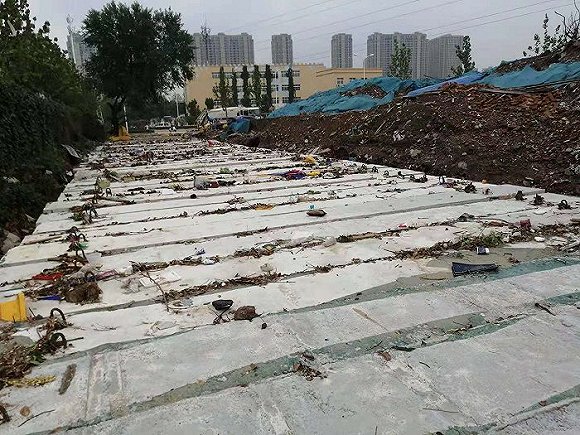By ZHAO Meng The causes of the deadly flood that brought a Zhengzhou Metro Line 5 t

A drainage canal near the breached Metro tunnel is covered, slowing down the diversion of flood. Pho
By ZHAO Meng
The causes of the deadly flood that brought a Zhengzhou Metro Line 5 train to a standstill last week could easily be put down to bad weather or bad luck. The area is notorious for flooding and heavy rain, though not quite so heavy as last week’s downpours.
However, one question being asked now is why Line 5 was the victim. A drainage ditch near the Wulongkou rail yard came into sight, it was covered by concrete slabs months ago before the tragedy, and was part of an urban renewal program.
On July 20, floodwater inundated a Metro train in Zhengzhou during the heaviest rain on record. Over 500 people were trapped, 14 of whom died. An immediate investigation concluded that the incident was caused by water overflowing into a low area prone to flooding, eventually breaching a retainer wall and pouring into the Metro tunnel.
A local government worker told Jiemian News that the Wukoulong drain was covered for the safety of pedestrians and vehicles and that there were plans under discussion to improve the environment of the area. When asked whether the concrete covering could have impeded drainage, she said that the issue “must have been” taken into consideration before decisions were made.
Given Wukoulong ’s history of flooding, why the slabs were allowed to be built? Could the tragedy have been averted? What measures, if any, were taken ahead of the storm?
The storm drain was built ten years ago, precisely to mitigate flooding. Paved over, it was unable to function as designed.
A low-lying area in Northwest Zhengzhou, Wukoulong has been home to HUANG Bo for 40 years. “The water was not just rising. It was flowing like a river. I could see it and feel it,” he said.
When he reached an intersection after wading for half an hour on July 20, he was horrified by streams flowing toward him from the other three directions. The water quickly rose to his waist and Huang turned back.
The Wukoulong intersection became a reservoir of water from all the surrounding streets. Close by a tunnel from a Metro yard leads directly into a station, one of the busiest in Zhengzhou. Eyewitnesses report a loud noise like an explosion, as a retainer wall collapsed and the entire reservoir poured into the tunnel and Huang noticed a sudden drop in the water level.
The wall in front of the Metro yard had disappeared, but there was still a lot of water on the other side street, where a drainage ditch was supposed to be. Anyone could see that the drain was not doing its job.
When Jiemian News arrived at the intersection on July 23, water was still being pumped out of the Metro tunnel. “This is the lowest point in the area,” Huang said. On the other side of the street was the canal, which, according to Huang, used to be a small river flowing across the neighborhood before it was covered and a road was built over it.

Flooding has long been a problem in the area. A 2009 analysis showed that water had to be at least one meter high on nearby roads before it could flow into the ditch which is now covered. The next year, with severe floods in the neighborhood, the ditch was dredged and turned into a canal. There have been plenty of similar cases in other cities of covered drainage canals causing flooding. Some stretches were brought back to the surface so that water could flow directly in and the flooding situation improved. During a thunderstorm three years ago, the water was “never higher than my knees,” according to Huang.
A few months ago, some exposed parts of the canal were covered again. A 50-meter stretch was covered solid with concrete slabs, and the narrow seams between them were packed with trash. The canal could still be seen in places. The water smelled bad and the banks were strewn with trash.
Zhengzhou’s preparedness for severe weather has also been called into question. From July 17 to July 20, the city suffered the heaviest rainfall in memory. From the afternoon of July 19, storm alerts were sent almost every hour. The alert went red that night, and another ten red alerts were issued during the day of July 20.
But the response, where it was, was inconsistent. People near Changzhuang Reservoir were never told whether to shelter in place or evacuate. Many went to work as usual. Despite the red alert, the school only asked parents to take kids home when the schoolyard was already flooded.
Red alerts are red for a reason. They are very rare and should have raised the alarm. But a local weather official who preferred anonymity told Jiemian News that the weather department doesn’t have real power and warning are often ignored or not taken seriously enough.
Zhengzhou’s emergency management plan states that all drainage canals should be left open, cleaned and monitored in advance of severe storms. But construction workers stationed in Wukoulong since June said no one had come to check the canal.

And so it came to pass that in the early evening of July 20, over 500 commuters got on the train and met disaster, fourteen of them never to make it home.
Four days later, the breached retainer wall is boarded up, the rail yard still a mess. Across the street, along the drainage canal, workers were covering the concrete slabs with green fabric. They are preparing to put down more paving. “No one told us to stop,” they said.